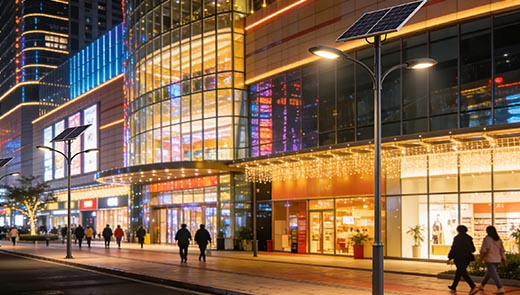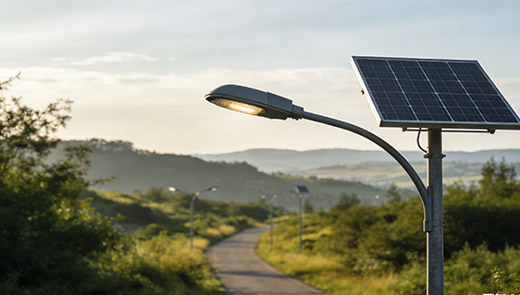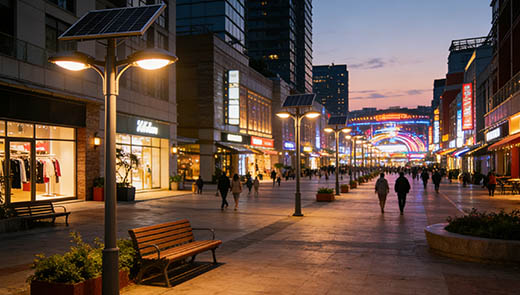How Do Solar Road lights Improve Our Lives?
Conventional street lights rely on grid power for a long period of time, which not only consumes a lot of energy and costs a lot of money to operate, but also becomes an important source of carbon emissions due to its reliance on fossil fuels for power generation, which is a constant burden to the environment.As an innovative lighting solution, solar streetlights are transforming solar energy into electricity through photovoltaic panels and storing it in batteries to realize autonomous lighting at night, which is gradually reshaping the lighting pattern of cities and communities. This article will start from the definition of solar street light, working principle, in-depth analysis of its environmental protection, cost, reliability and other advantages, and how to improve our lives, and provide practical reference for the choice of solar street light.
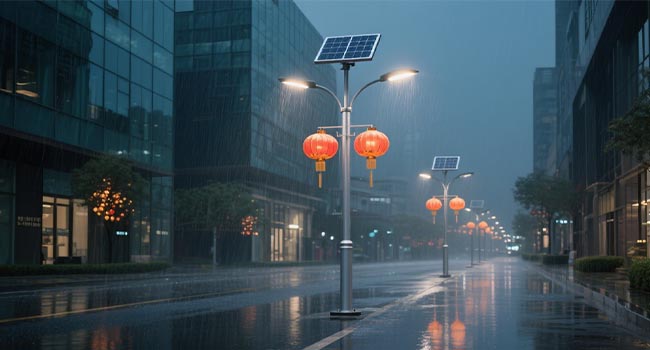
What Is Solar Street Light?
Solar street light is a kind of outdoor lighting equipment using sunlight as energy source, its core composition includes solar panels mounted on light poles or lighting structures, these panels absorb sunlight during the daytime and charge the built-in rechargeable batteries, and at night the batteries release electricity to power the street lights, completely free of the dependence on the traditional power grid.
Today's solar streetlights are carefully designed to operate uninterruptedly with minimal human intervention, and are suitable for commercial scenarios such as city roads and parks, as well as meeting the lighting needs of residential areas. They are not only aesthetically pleasing, but also have a long service life and low maintenance requirements, while being cost-effective and environmentally friendly, making them an ideal choice for modern lighting.
How Do Solar-Powered Street Lights Work?
The core logic of solar street lights is to convert solar energy into electricity and utilize it appropriately. The key component is the solar panel (also known as photovoltaic panel), which is usually made of polysilicon. During the day, the photovoltaic panel absorbs sunlight and uses the photoelectric effect to convert solar energy into electricity, which is stored in a special battery through an intelligent control system. At night, when the ambient light intensity decreases to a certain level, the controller will automatically activate and transfer the electricity stored in the batteries to the light source, thus realizing the nighttime lighting function, and the whole process is completely automated without manual operation.
Advantages of Solar Street Light Systems
Environment Friendly
Conventional street lights rely on grid power, which is produced by fossil fuels such as coal and natural gas, which release large amounts of carbon dioxide and other greenhouse gases during combustion, exacerbating climate change. Data shows that traditional streetlights account for 30-100% of local government's total carbon emissions, making them a significant source of carbon emissions.
In contrast, solar street lights utilize solar energy and do not produce any carbon emissions during operation, fundamentally reducing the carbon footprint of the lighting segment. In addition, the installation of solar street lights does not require excavation of the ground to lay cables or complex external power supply infrastructure, minimizing damage and interference to the ecological environment, and reflecting significant environmental advantages throughout the entire life cycle from installation to use.
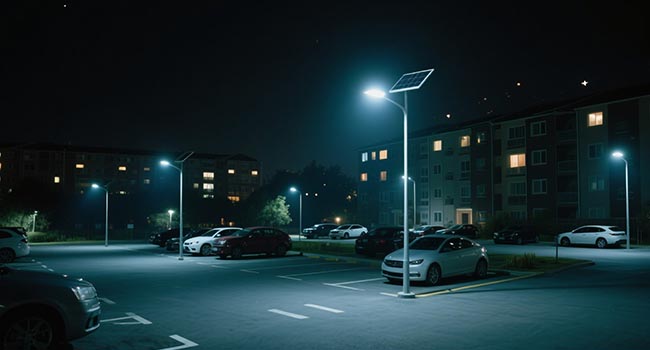
Cost Effective
The advantages of solar street light in terms of cost throughout its life cycle. From the point of view of energy consumption, traditional street lights rely on the power grid and incur high monthly electricity costs, while solar street lights rely entirely on solar energy, almost no energy costs. In terms of service life, traditional streetlights such as incandescent lights and high pressure sodium lights usually have a rated life of 2000-29000 hours, while solar LED lights can have a rated life of 15000-50000 hours, which is about 7 times that of traditional streetlights, which means that the replacement frequency of solar streetlights is much lower, thus greatly reducing the cost of replacement. This means that solar street lights are replaced less frequently, greatly reducing the replacement cost.
In terms of maintenance, traditional lights (e.g. high pressure sodium lights) usually need to be replaced every 5 years, which is frequent and expensive, while solar street lights only need to clean the panels and replace the batteries on a regular basis, so the maintenance cost is extremely low. In the long run, the initial investment in solar streetlights can be offset by the cumulative savings in electricity and maintenance costs, resulting in net-zero costs in most cases, with tangible economic benefits for communities and individuals.
High lifespan
solar street lights are far more durable and reliable than traditional street lights. The LED light source has an extremely long lifespan and can maintain a stable lighting effect for a long period of time, reducing the problem of lighting interruption caused by damage to the lights and lanterns. What's more, solar street lights rely on built-in batteries to store electricity and do not rely on the power grid, so even in unexpected situations such as power outages, they can still work normally to ensure the continuous lighting of roads, neighborhoods and other public areas, which is of great significance for ensuring nighttime travel safety and responding to emergencies, and greatly improves the reliability of the lighting system.
Easy to Install
Most of the modern solar street lights adopt integrated design, which integrates core components such as solar panels, batteries, motion sensors and control modules, which makes the installation process easy and fast. Compared with traditional street lights, solar street lights do not require complex electrical wiring, supporting power supply infrastructure, nor do they need professional electricians to carry out tedious wiring operations. When installing, it only needs to be fixed on the pole or flat surface, whether it is the city center, remote villages or areas with no grid coverage, it can be easily installed and used, which greatly reduces the requirements for the installation environment and professional technology, and improves the popularization efficiency of lighting facilities.
High Technology
The high quality solar street light incorporates a number of advanced technologies for better performance. In terms of solar panels, the efficiency of monocrystalline silicon solar panels is higher than that of polycrystalline silicon solar panels, which can provide 20% of the maximum power to ensure efficient power generation under limited light conditions; in terms of energy storage, with high-quality storage equipment such as deep-cycle lead-acid batteries, the service life of which can be up to 5-7 years, guaranteeing a stable long-term supply of energy.
In addition, many solar street lights are equipped with intelligent control systems and motion sensors, which are able to provide a stable long-term supply of energy. In addition, many solar street lights are equipped with intelligent control systems and motion sensors, which can automatically adjust the lighting brightness and time according to the ambient light intensity and personnel activities, further optimizing the energy efficiency and enhancing the user experience.
Things to Consider When Selecting Outdoor Solar Lights
Purpose
Before purchasing solar street lights, first of all, you need to clarify their specific purpose. Is used for roads, parking lots and other areas of the security lighting, the need for sufficient brightness and coverage; or for parks, courtyards and other places of landscape lighting, pay more attention to the appearance of the design and atmosphere. The brightness, irradiation range, modeling and other requirements of street lights vary greatly between different uses, and only by clarifying the use can we choose the product that best meets the needs.
Brightness
Brightness is a key indicator to measure the lighting effect of street lights, and the international common unit is lumen, which can more accurately reflect the actual lighting effect than the previous way of measuring brightness by wattage. For example, an ordinary 40-watt incandescent lamp produces between 300-500 lumens, while LED lights only need 3-5 watts to achieve the same brightness. When choosing, you need to determine the appropriate lumen value according to the size of the scene, the strength of the lighting demand and other factors to ensure that the lighting effect meets the actual demand.
Solar Panel Type
Solar panel is the core component of solar street light, and its type directly affects the power generation efficiency and applicable scenes. There are three common types of solar panels: amorphous silicon solar panels with a single photovoltaic layer, although covering a large area, but light weight, good flexibility, suitable for curved surfaces or special modeling installation scenarios. Monocrystalline silicon solar panels are based on a single silicon crystal, which is hard and heavy, but has the highest power generation efficiency and can generate more electricity under the same light conditions, which is suitable for scenarios that require higher power generation efficiency. Polycrystalline silicon solar panels are fused from multiple silicon crystal fragments, with performance close to that of monocrystalline silicon, but at a lower cost, making them more cost-effective and suitable for more cost-sensitive scenarios.
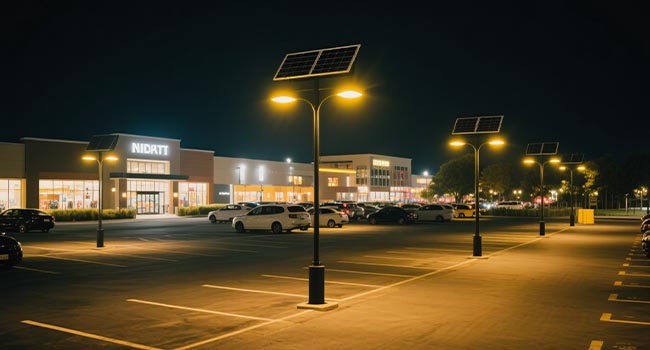
Battery Type
Battery is the key component of solar street light to store electricity, which directly affects the range and service life of the street light. Common battery types include lead-acid batteries, nickel-cadmium batteries (NiCd) and nickel-metal hydride batteries (NiMH). Lead-acid batteries generate electricity through the chemical reaction between sulfuric acid and lead, which is lower in cost but heavier in weight and relatively shorter in life. NiCd batteries have better low-temperature performance and cycle life, but they contain toxic substances and are not friendly to the environment. NiMH batteries have a larger capacity and better environmental protection performance, but they are relatively higher in cost. When choosing, according to the temperature of the environment, the requirements of the endurance and environmental protection needs and other factors, comprehensive consideration to choose the right type of battery.
Recharge and Run Time
The charge time and run time of solar street lights are important indicators of their practicality. Charging time mainly depends on the efficiency of the solar panel and light conditions, the higher the efficiency, the more abundant light, the faster the charging speed; running time depends on the battery capacity and lighting power, the larger the capacity, the lower the power, the longer the running time. When choosing, it is necessary to ensure that the street light can be fully charged during the day under normal lighting conditions and can meet the lighting demand at night, and it is best to have some redundancy to cope with special circumstances such as continuous cloudy days. At the same time, care should be taken to avoid over-discharging the battery, as frequent battery depletion will significantly shorten its service life.
With the multiple advantages of being environmentally friendly, economical, durable, easy to install and technologically advanced, solar street lights are fundamentally changing the way we light and the quality of our lives, bringing more sustainable lighting solutions to cities and communities. When choosing, you can find the most suitable product by combining the specific use, brightness demand, solar panel and battery type, and charging and discharging time, etc. With the continuous progress of technology, it will play an increasingly important role in promoting the construction of green cities and improving the living environment, and injecting more clean energy into our lives to bring us light and well-being.

